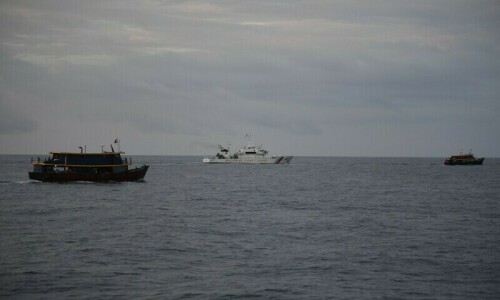Basic economics suggests that if a country’s saving rate is below its investment rate it will always find it difficult to achieve stable and sustainable growth. Except for a few years since our independence, we have struggled to get beyond a single-digit saving rate. The gross saving rate as of June 30, 2020, was 8.4 per cent. This rate is low when compared to South Asian countries.
India is at 29.44pc, Bangladesh is at 24.75pc and Nepal at 36.2pc. According to a Gallup survey commissioned by the State Bank of Pakistan, 64pc of the survey respondents stated that they save either in cash or informal savings. Given the low level of absolute savings, the inference is that the bulk save in cash, however nominal the saving amount may be. This conclusion is further strengthened by the fact that Pakistan also has the highest currency-to-deposit ratio, namely 36.2pc in the region.
This Rs6.3 trillion — printed yet not within banks or other formal investment vehicles — is where the solution to increasing our saving rate lies. Bringing this cash into the formal economy will reap immense benefits. If the cash in circulation was reduced by Rs1tr, it would lead to a Rs3tr increase in the national deposit base due to the bank multiplier effect.
In order to achieve our Rs1tr objective of bringing cash into the formal economy we must adopt the customer lens, review the customer journey and the commercial returns. The irony is that Pakistanis save, they just don’t save within the formal system: 23pc via the committee mechanism, 16pc in gold and another 11pc through livestock. If we could institutionalise these savings mechanisms, provide a better return and easier customer journey for those who want to save through the formal banking instructions we would start to crack our low saving rate problem.
The irony is that people save, just not within the formal system: 23pc via the committee mechanism, 16pc in gold and another 11pc through livestock
The committee system is an informal mechanism for people to save. It is popular in emerging markets around the world as it does not require either a bank account and is without any interest component. Let’s say ten people get together, each contributes Rs 1,000 per month for 10 months. Every month there is a pool of Rs 10,000 which one individual gets on the basis of a lucky draw or reverse auction. This is a cash transaction as each member contributes Rs1,000 in cash and it is unlikely that the monthly Rs10,000 recipient deposits this amount in a bank account. The Gallup study earlier alluded to suggests that a material amount of savings may be though the committee system as opposed to cash under the pillow.
We can start by firstly digitising this process. Instead of the 10 individuals meeting or one individual collecting physical funds, all 10 download an app which caters for this service. The app allows them to instantly open a mobile wallet by simply sending an SMS. It populates their account though either linking an existing bank account or depositing cash at any of the 90,000 branchless banking agents. It also allows them to transfer money in real-time to an individual who is that month’s beneficiary. The beneficiary can then hopefully use the funds to make an online utility bill payment, school fees, e-commerce purchases or physically withdraw the funds from a branchless banking agent.
From the customer lens, a service which is user friendly has been provided. From the country’s perspective, cash has been brought in the formal economy.
A more advanced version of the solution envisages a platform where all of the above-mentioned services are provided with one major addition. The platform provider underwrites the performance risk of the committee members. Imagine 10 people in 10 different cities, who do not know each other, but wish to participate in a committee to save are brought together by the platform provider after screening them to ensure its credit criteria is met. The platform provider, using advanced credit underwriting techniques, guarantees that each individual will pay their contribution for the duration of the committee. In this version, social capital to ensure monthly contributions is replaced by the guaranty of the platform provider.
Pakistanis, as is the case with other South Asians, are partial to savings in gold. Pakistan in the last fiscal year imported 273kg of gold, worth $11.9 million which translates to billions of rupees. About 99pc of the gold imported is converted to jewellery and used as ornaments as well as a medium of savings for the bottom of the pyramid.
The World Gold Council estimates an annual consumption of 150 to 170 tonnes annually. As there is no regulatory oversight for the purchase of gold, most of these transactions are in cash and do not necessarily enter the formal economy. Now imagine an app that provides fractional gold purchases — meaning Rs 100 denomination — provides a market-based buy and sell price and instant liquidity. An app that only allows purchase and redemption through a bank account with full know-your-customer and anti-money laundering screening. The customer gold account is credited with the grams they buy and physical delivery is available when one gram is achieved, although liquidity, i.e. ability to sell, is available in real-time. A solution like this would bring the ability to save in gold on a fractional basis, provide liquidity, transparency and security and, most importantly, start to bring cash transactions to the formal economy.
Pakistanis save but not with financial institutions as the medium of savings offered by them does not meet their needs. When banks and fintechs start viewing the savings need through the customer lens then a behavioural change can take place and informal savings can be moved to formal ones: the roadmap is available. What is now required is the will.
The writer is a tech entrepreneur
Published in Dawn, The Business and Finance Weekly, September 21st, 2020















































